
Introduction
The American Angus Association (AAA) was established in the USA in 1883 and has grown to be the world’s largest beef breed association. In 2018 registrations totalled 327,067, a level that has remained relatively constant in recent years. Annual registrations of Angus in the USA total more than the next 10 largest breeds combined. The exact net influence of the breed on the nations beef industry is difficult to quantify exactly. Considering information from bull turn-out surveys, it is estimated that the Angus content of the nation’s herd is around 70 percent. This comes not only from registered Angus bulls, but hybrid and composite bulls with significant Angus content. A review of the American Simmental Association top 100 sires used indicates the average Angus breed composition is 26% within that breed (American Simmental Association, 2018). Similarly, Angus hybrids in the Limousin and Gelbvieh breeds branded as Limflex and Balancer, respectively also convey Angus genetics to the national herd. Through many different channels the US beef industry is heavily influenced by the genetics of Angus cattle. With the breed having such a large influence, the genetic direction and advancement in the breed also determines the long-term advancement of the industry. This paper discusses how both a demand for fed cattle through the Certified Angus Beef Brand and the role the Angus cow plays in the cow herd have contributed to the strong demand for Angus genetics. Long-term growth of any brand cannot be sustained without a quality product to back it up and the continued genetic advancement of the breed through performance recording, genetic evaluations (EPD), selection indexes ($Values) and genomics have all played a role in this advancement. The long-term success of the breed will require a continued balanced approach to selection and results of a new survey of breeders has highlighted the breeder’s emphasis for the future. Finally, a new program that places genetic information on commercial calves at the point of sale is the Associations newest program to continue to drive demand for quality Angus genetics.
Creating Demand for Angus Beef
The ultimate success of any breeding program will be determined in the commercial market place. Simply selling genetics amongst breeders is not success. To be truly successful there must be a commercial demand for the genetics. In the case of Angus, the role the Certified Angus Beef (CAB) Brand has played and continues to play cannot be overlooked. Started in 1978, CAB was not an overnight success, but is now widely recognized as the original and world’s largest fresh beef brand (McCully 2018). In 2018 there were 1.215 billion pounds of CAB sold, an increase of 8.1% from 2017. To meet this demand the commercial sector also produced a record number of cattle with 5.18 million meeting the Angus type and 10 quality-based specifications for the brand, a 14.3% increase over 2017 (Certified Angus Beef, 2018). It is this strong demand for quality beef that is driving the commercial demand for quality bulls. Simply having Angus bulls is not good enough. Of the Angus type cattle that do not qualify for CAB, 90% fail due to inadequate marbling (McCully 2018) making continued emphasis on improving carcass traits important to breeders.
Genetic Improvement Program
The story of genetic improvement for carcass traits in the Angus breed is an excellent example of technology adoption. The genetic trend for carcass quality and the role ultrasound scanning has played is a true success story. This relationship is obvious when one lines up the AAA marbling genetic trend with the adoption of ultrasound scanning (Figure 1). Considering a lag between scanning bulls and subsequent gains in progeny it is clear that ultrasound has played a large role in this genetic progress. It is also a testament to the cattle breeders’ ability to take a measurement on a live animal that is heritable and turn it into genetic gain. This progress is facilitated through Angus’s National Cattle Evaluation (NCE) using scan records and carcass data in a joint model, with ultrasound providing indicator traits that are highly correlated to carcass records. The AAA has a long history in adoption of selection technologies with the publishing of the first sire evaluation report in 1974, with NCE adopted in 1985 which became joint with the Canadian Angus Association in 2000. In 2001 the transition of EPD calculations to an ‘in house’ procedure began and in 2004 the first $Value selection indexes were released.
Figure 1: Angus genetic trend for marbling and recording of carcass and ultrasound.
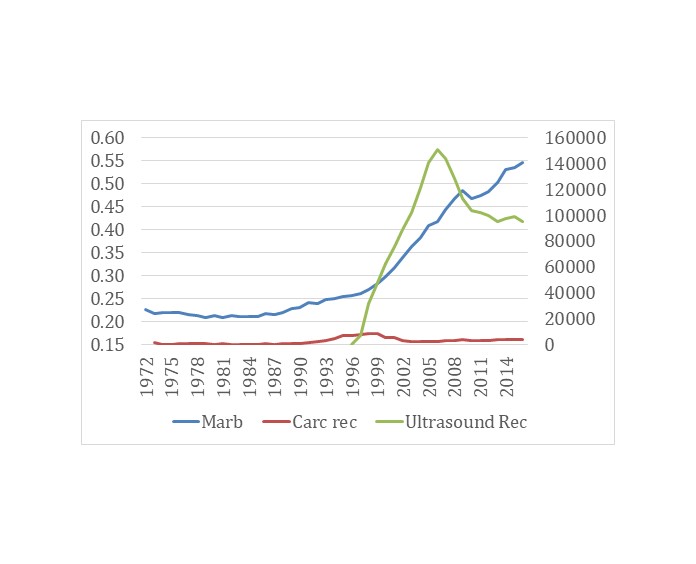
Angus Genetics Inc (AGI), was established in 2007 as a wholly owned for profit subsidiary of AAA. As a company it performs genetic evaluation services for Angus as well as other breeds. Today AGI services the US and Canadian breed associations for Angus and Charolais as well as the American Maine Anjou Association and the International Senepol Cattle Breeders Association. In 2009 AGI launched the first genomically enhanced EPD for the breed, an advancement that has continued to grow. The Angus NCE updates new pedigree, performance and genomic information weekly and has now been run continuously for 430 consecutive weeks. A summary of the suite of traits evaluated and the information behind them is summarized in Table 1. This represents a joint evaluation of the American and Canadian Angus Association’s data. Although smaller, the Canadian Angus Association contributes a significant proportion of data to some developing traits, such as heifer pregnancy, which is just one example of the benefit of joining multiple countries in a joint evaluation.
Table 1: Summary of data (1) used in Angus genetic evaluation.
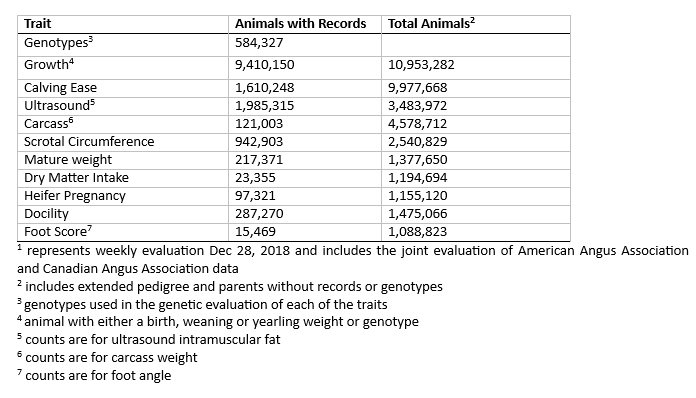
The first ‘trait’ listed in Table 1, is the total number of animals ‘genotyped’. In this context, genotypes refer to animals genotyped with a medium to high density genotyping array that contribute 50K SNP markers into the Single-Step genomic evaluation. The AAA stores all DNA samples onsite and now has 1 million samples, that will have been submitted for genotyping for genomic prediction, parentage or genetic condition testing. In 2018 there were 162,469 genomic tests submitted for genetic evaluation purposes, a 28.3% increase from 2017. Now about half of all animals registered are genotyped, an area that continues to grow. The growth in genomic testing is illustrated in Figure 2. In 2017 AGI reduced the price for a 50K genotype from $45 to $37. When applied to the animals genotyped in 2018, this represented a $1.3M saving to breeders. This increased value in genomic testing has resulted in a growth in female genotyping, which will further improve the accuracy of the genetic evaluation by better characterizing the dam or ‘bottom side’ of the pedigree.
Figure 2: Genomic testing in male and female American Angus cattle overtime.
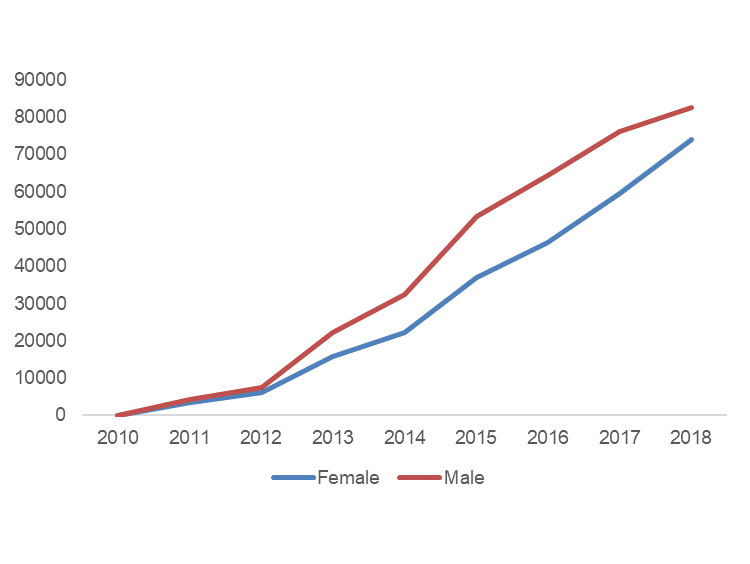
Like performance testing, Angus breeders have fully embraced genomics as the next tool to expedite genetic improvement. The genetic evaluation includes all genotyped animals in all trait predictions allowing a genotyped animal to receive a genetic prediction for all traits. Take feed intake as an example of a trait that is expensive and hard to measure. There are just over 23,000 animals with feed intake measured, but all genotyped animals will receive an EPD through their relationship to measured animals as determined with the genotypes.
Emphasis on Maternal Traits
Angus dominates the market place, not just because of the demand for CAB and the progress breeders have made in end product traits, but due to the Angus cow’s place in the commercial cow herd as well. Angus is a breed that is used to not only produce CAB, but are an important component of most maternal ‘mother cow’ programs, termed ‘suckler cows’ in the UK. To continue to improve traits important in the maternal herd a number of EPD have been launched including maternal calving ease and mature weight in 2005, heifer pregnancy (fertility) and docility in 2012 and foot score was in 2018. It is important for breeders to be able to properly balance gains in terminal traits like growth and carcass against traits important in the cow herd. This focus among breeders on maternal traits are well illustrated in Figure 3 and Table 2.
Figure 3: Response to survey about $Value indexes and trait prioritization across industry segments.
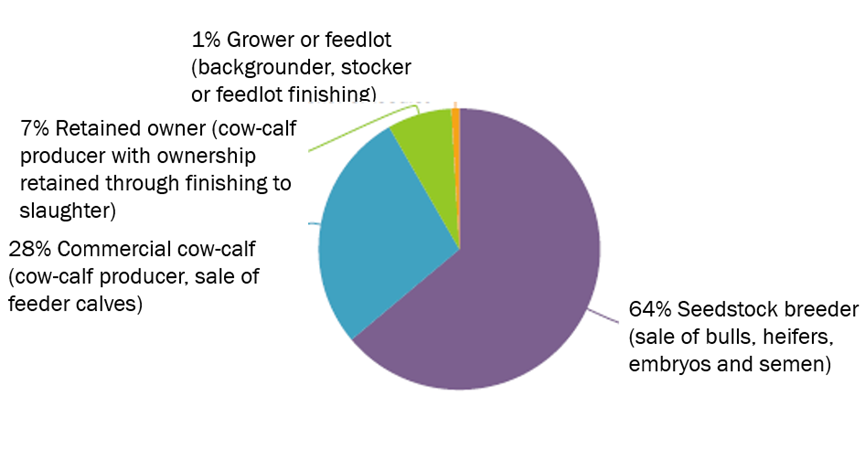
These are the result of a survey that was conducted in conjunction with consulting company AbacusBio from New Zealand that targeted Angus breeders and commercial operators as well. The project is reviewed the current Angus $Value breeding indexes and was aimed partially at understanding trait priorities among industry segments. Figure 3 illustrates how the respondents break down across seedstock and commercial segments. As expected, response was highest from Angus breeders, but also included an excellent response from the commercial segment as well. Across all these segments Table 3 illustrates how important ‘cow traits’ are with all of the top-ranking traits, clearly related to the cow herd. The top 4 traits were cow survival, docility, foot score and heifer pregnancy. Cow survival is a trait for which there is no direct EPD currently, although breeders can get at important components of survival such as fertility and foot structure with the EPD available. This survey reinforces the need for a cow survival or longevity EPD, something that is a current research priority for the association.
Table 2: Average response (average rank) to $Value breeding index survey across 2,033 respondents.
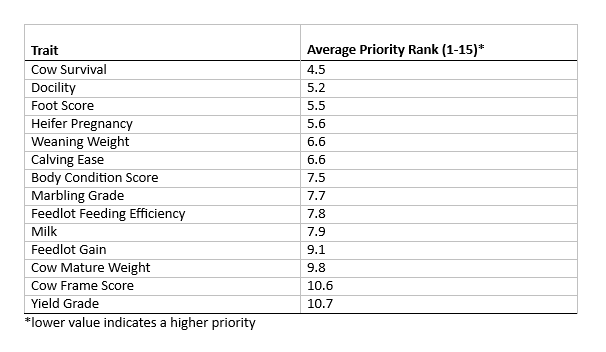
In 2015 the American Angus Association launched a program to enable breeders to collect and submit foot scores. The AAA scoring system is illustrated in Figure 4. In 2016 a new long-term strategy for the Association was launched and one of the top priorities for research was foot structure. To address this need an EPD was developed and launched as a research EPD in 2018, with a 2019 official EPD likely. Analyses of the foot scores recorded as illustrated in Figure 5. Indicate that the majority of scores that are not ideal (5) are greater than 5 on the 1–10 scale. If there is a problem with foot angle it is most likely to be too shallow and with claw set the problem is a propensity to cross over. The resulting EPD then only considered scores 5–10 on each scale as this is where the majority of the data lies. Both foot angle and claw set were determined to be moderately heritable (0.25) indicating that the records as scored by breeders were sufficiently accurate to develop an EPD.
Figure 4: Foot angle and claw scoring guide for American Angus cattle.
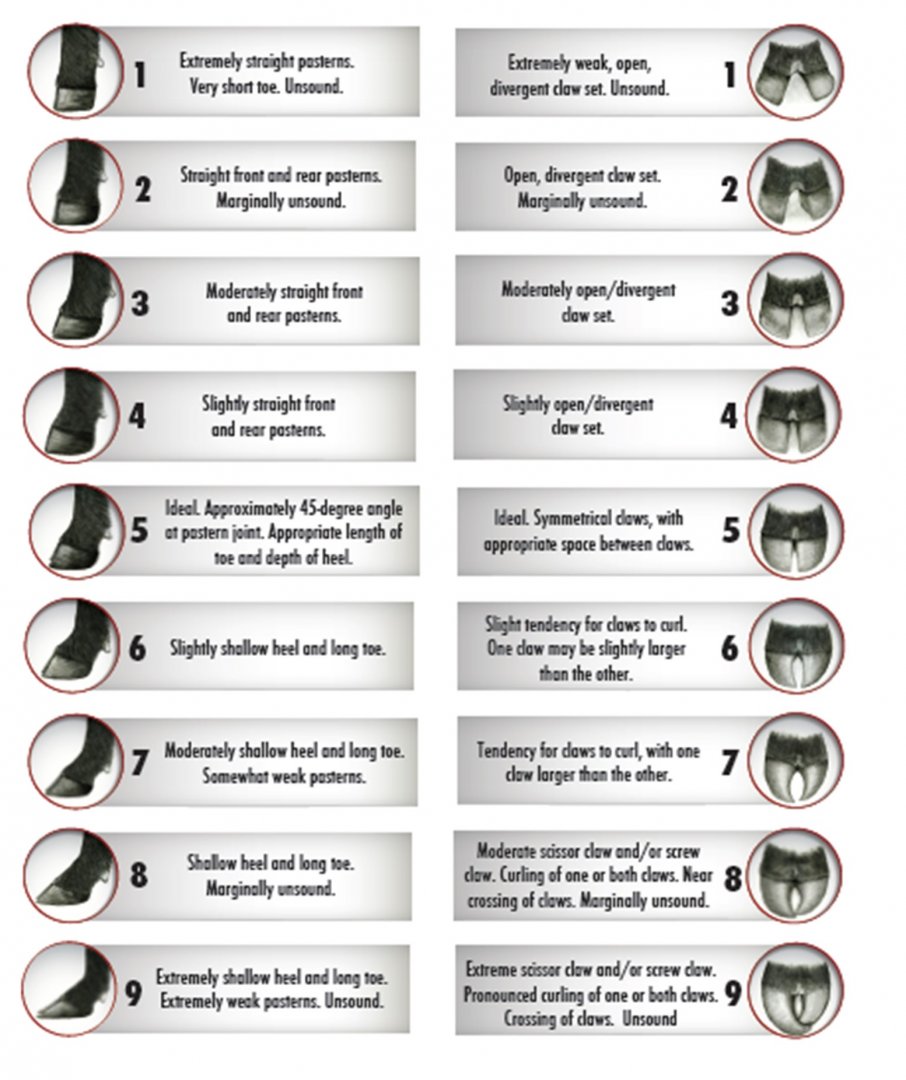
Figure 5: Distribution of Foot scores recorded by American Angus breeders across two age classes.
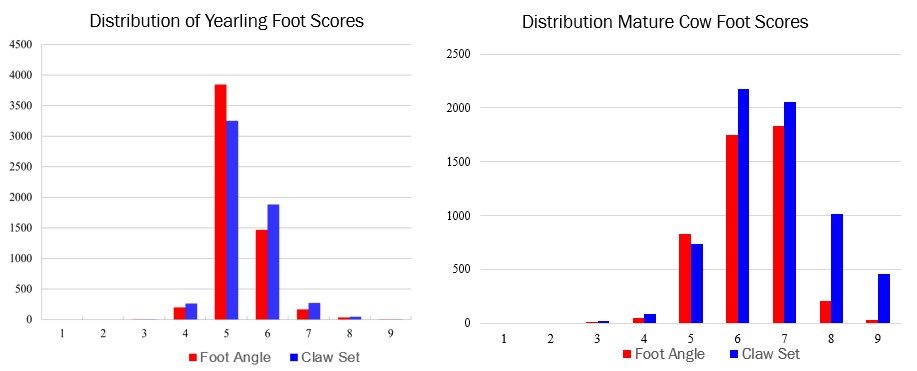
Introducing Angus LinkSM
In 2018 American Angus launched a new program for commercial calves called Angus LinkSM. The chain of genetic information has always been strong on the seedstock end of the industry through to the sale of a bull to a commercial cow-calf producer, but after that this information chain was broken. At the point of sale for a commercial calf, which is typically a live or video auction, there has been little to no genetic information available on calves. Angus LinkSM now connects this information chain by placing 3 scores related to feedlot performance and carcass grading ability as well as an overall profitability score based on ancestor EPD, considering multiple breeds. This program has the potential to increase genetic progress by creating a stronger demand for bulls with better EPD.
Consider the value progression as illustrated in the flow diagram in Figure 6. Once the Angus LinkSM scores are respected in the market place, calves with better scores will sell for more money (bubble 1). Once the commercial calf producer realizes that calves with better scores are bringing more money, they will purchase bulls with EPD that will increase their calves scores (bubble 2). As commercial cow-calf producers increase their emphasis on traits that increase calf scores (EPD for relevant traits), they in turn drive demand and pay more for bulls that fit this criterion (bubble 3). With seedstock breeders realizing bulls that have an EPD profile that better fit the Angus LinkSM program are in stronger demand and are bringing higher prices, they will adjust their selection emphasis to meet this demand and increase genetic progress (bubble 4). In the end the market will determine the value of EPD traits and the Angus LinkSM program simply places these EPD values into the market place in a more direct way to allow this value to be determined.
Figure 6: Flow diagram illustrating how a genetic score on a commercial feeder calf can increase genetic progress at the seedstock level.
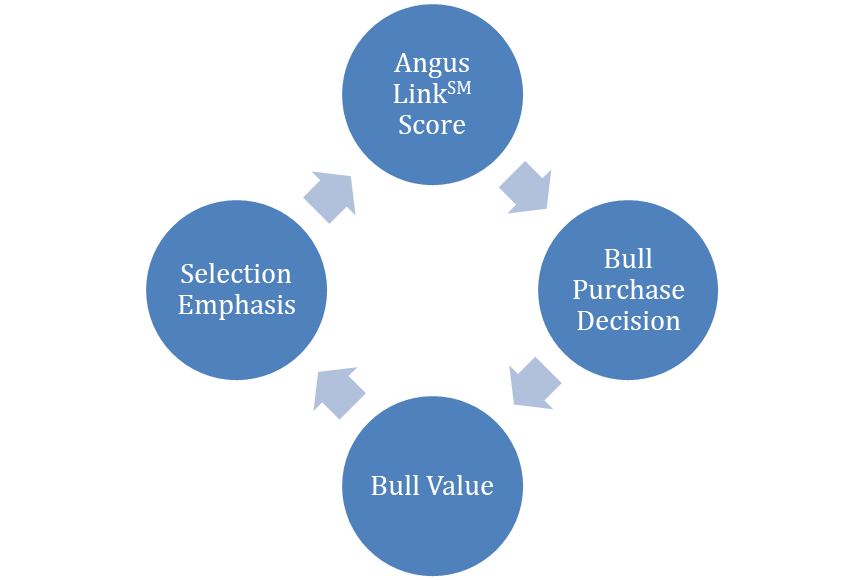
In Conclusion
The Angus breed has risen to be ‘America’s Breed’ where it dominates the market. Claiming this position has been the result of a strong demand for Angus cattle in the feeding and meat industry as well as in the cow herds throughout the country. Meeting all these demands for genetic performance is not easy and Angus breeders have been dedicated to performance recording, EPD, selection indexes and now genomics to make the cattle that meet the market. The demand for better cattle will never stop and hence the cattle breeder’s job is never done. Always focused on the commercial market, the future of Angus breeding will continue to be one of employing the latest in technology to drive positive change forward.
References Cited
American Simmental Association 2018, https://herdbook.org/simmapp/action/pages. PagesAction/eventSubmit_displayPage/T/ pageId/14/ Accessed Dec 27, 2018.
Certified Angus Beef, 2018. https://news.certifiedangusbeef.com/certifiedangus- beef--brand-marks-12th-consecutiveyear- of-record-sales/ Accessed Dec 27, 2018.
McMully, M. 2018. Positioning for the future of beef production – focus on quality. Beef Improvement Federation Annual Research Symposium. June 22, Loveland CO.